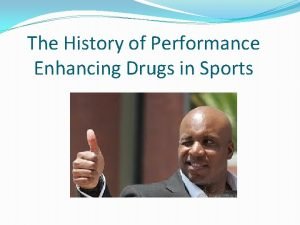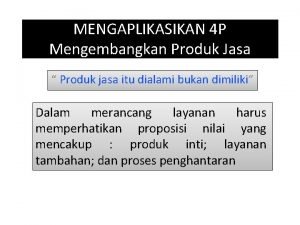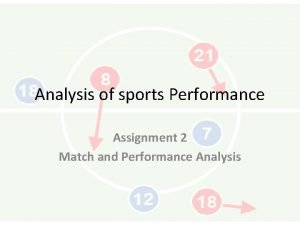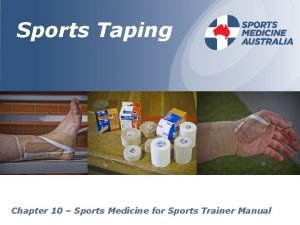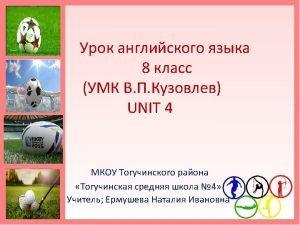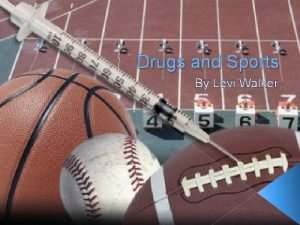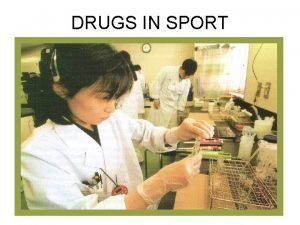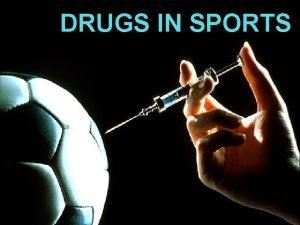The History of Performance Enhancing Drugs in Sports







































- Slides: 39

The History of Performance Enhancing Drugs in Sports

When do you think that performance enhancing drugs were first used in sports?

776 BC to 393 BC �Ancient Greeks use performance enhancing drugs. �The word “doping” is attributed to the Dutch word “doop, ” which is a viscous opium juice, the drug of choice for ancient Greeks. They also gorged on meat, something they usually did not eat, to enhance performance.

100 AD �Roman gladiators use stimulants and hallucinogens to prevent fatigue and injury during chariot races. �They also fed their horses substances such as hydromel (an alcoholic beverage made from honey).

100 AD �Gladiators also ingest hallucinogens and stimulants such as strychnine to stave off fatigue and injury and to improve the intensity of their fights.

Late th 19 Century �French Cyclists and Lacrosse Players Drink Wine and Coca Leaves to Fight Fatigue and Hunger. �Vin Mariani, a widely used mixture of coca leaf extract and wine, was even called 'the wine for athletes. ' It was used by French cyclists and. . . by a champion lacrosse team. Coca and cocaine were popular because they staved off the sense of fatigue and hunger brought on by prolonged exertion.

1904 -1920 �In 1904 Olympics marathon runner, Thomas Hicks, was using a mixture of brandy and strychnine and nearly died. �Mixtures of strychnine, heroin, cocaine, and caffeine were used widely by athletes and each coach or team developed its own unique secret formula. �Common practice until heroin and cocaine became available only by prescription in the 1920 s.

1928 �First Rule Against Doping in Sports (Track and field) �The International Association of Athletics Federation (IAAF), the governing body for the sport of track and field, become the first international sporting federation to prohibit doping by athletes

1940 -1945 �Nazis Test Steroids on Prisoners and Hitler �Nazis test anabolic steroids on prisoners, Gestapos and Hitler himself [between 1940 and 1945]. �Testosterone used by German soldiers to promote aggressiveness and physical strength. �Retrospectively, according to his physician, Hitler's mental state toward the end of his life exhibits characteristics that some scientists associate with heavy steroid use: mania, acute paranoid psychoses, overly aggressive and violent behavior, depression and suicidal ideologies

1940 -1945 �Soldiers Use Amphetamines During WWII �The American, British, German, and Japanese armed forces distribute amphetamines to their soldiers to counteract fatigue, elevate mood, and heighten endurance. The amphetamines are used as a substitute for cocaine because they can be taken orally in tablet form, and the effect lasts much longer.

1950’s �Athletes Begin Taking Amphetamines Used by Soldiers in WWII �Amphetamines crossed over into sports in the early 1950 s. These drugs -- nicknamed la bomba by Italian cyclists and atoom by Dutch cyclists -- minimize the uncomfortable sensations of fatigue during exercise. "

1958 �FDA Approves First Anabolic Steroid for Sale in US �The "Godfather of Steroids, " Dr. John Bosley Zieglar, creates an anabolic steroid called Dianabol that is released by Ciba Pharmaceuticals with FDA approval. �Dr. Zieglar noted the success of the Russian weightlifting team due to the use of testosterone in 1954 and began experimenting on US weightlifters. His creation synthesizes the strength-building properties of testosterone while minimizing the negative health effects.

1960 -1990 �Aug. 26, 1960: First Athlete to Die in Olympic Competition Due to Doping �Danish cyclist, Knut Jensen, dies on Aug. 26, 1960 at the Summer Olympics in Rome during the 100 km team time trial race. His autopsy reveals traces of an amphetamine called Ronicol. Jensen is the second athlete ever to die during the Olympic games

1967 �Cyclist on Amphetamines Becomes First Death Due to Doping in the Tour de France �British cyclist Tommy Simpson dies during the 13 th stage of the Tour de France on July 13, 1967. The cyclist, whose motto was allegedly "if it takes ten to kill you, take nine and win, " consumes excess amounts of amphetamines and brandy to combat the effects of an illness and he continues to ride until his body shuts down. � Simpson's death creates pressure for sporting agencies to take action against doping

1967 �International Olympic Committee (IOC) Establishes Medical Commission to Fight Doping �Partly in reaction to Tommy Simpson's death, the International Olympic Committee (IOC) establishes the Medical Commission to fight against doping in sports. The Commission is given three guiding principles: protection of the health of athletes, respect for medical and sport ethics, and equality for all competing athletes.

1968 �First Drug Testing at Olympic Games �First Horse Disqualified from Kentucky Derby for Banned Substance �First Olympic Athlete Disqualified for Doping Violation �Hans-Gunnar Liljenwall, a member of the Swedish modern pentathlon team, was stripped of his bronze medal at the Mexico City Olympics when he tested positive for excessive alcohol.

1975 -1976 �Anabolic Steroids Added to IOC's Banned Substances List �Anabolic steroids are added to the IOC's list of banned substances because a test that is considered to be reliable is developed. �Athletes are first tested for anabolic steroids during the 1976 Olympic Games in Montreal.

1983 �Surprise Drug Testing at Pan Am Games Leads Many Athletes to Withdraw from Competition � The modern age of drug testing essentially started at the 1983 Pan Am Games in Caracas, Venezuela. A team of scientists. . . developed a new method for steroid testing in anticipation of two large international sporting events that year, the Pan Games and world track and field championships. . . � The Pan Am drug testing caught a lot of athletes by surprise. . . a dozen American athletes in various events suddenly withdrew from the competition and returned to the U. S. , and at least another dozen athletes from other countries also left without explanation. � Nineteen athletes in total failed drug tests at the 1983 Pan Ams.

September 27, 1988 �Ben Johnson Stripped of Gold Medal after Positive Drug Test �Johnson, a Canadian sprinter, is stripped of his gold medal at the 1988 Olympic Games in Seoul, Korea after testing positive for stanozolol, an anabolic steroid. Johnson claims that his herbal drink was spiked, but officials decline his explanation and suspend him from competition for two years. � Johnson is later banned for life after a second positive test in 1993.

November 18, 1988 �As part of his War on Drugs program, President Ronald Reagan signs the Anti-Drug Abuse Act of 1988 , outlawing the sale of steroids for non-medical purposes. The law adds penalties for crimes involving minors and the sale of drugs within one hundred feet of schools, to address concerns about high school students using steroids.

1991 -1999 �June 7, 1991: Major League Baseball Bans Steroids �Major League Baseball Commissioner Fay Vincent sends a seven page memo to all of the major league teams on June 7, 1991 that states: "The possession, sale or use of any illegal drug or controlled substance by Major League players or personnel is strictly prohibited. . . This prohibition applies to all illegal drugs and controlled substances, including steroids. “ �Conveniently, there is no enforcement in testing.

1992 �Former NFL Player Dies of Brain Cancer after Using Steroids and HGH for Two Decades �NFL defensive end Lyle Alzado dies of brain cancer on May 14. The 43 -year-old two-time All-Pro believed his disease was the result of more than two decades of steroid and HGH use.

1994 �First British Female to Test Positive for PEDs Receives Four Year Ban �Diane Modahl, becomes the first British female athlete to test positive for performance enhancing drugs. She is banned from competition for four years in a ruling by the British Athletic Foundation (BAF) on Dec. 15, 1994. �One year later, she is cleared of the charges because of the possibility that the sample was not refrigerated

1997 �Bud Selig Issues Memo Repeating the MLB Ban on Steroids �On May 15, 1997, acting commissioner Bud Selig distributed a nearly identical version of the [1991 Fay Vincent] drug memo, again citing steroids and directing clubs to post the policy in clubhouses and distribute copies to players. Selig's memo also went largely ignored. �In 2005, ESPN spoke to five GMs from 1997, three of whom (from the Royals, Dodgers and Rockies) couldn't recall that a steroids policy even existed

1998 �Mark Mc. Gwire Admits to Using a Steroid Precursor �A jar of androstenedione is discovered in the locker of St. Louis slugger Mark Mc. Gwire, who is neck and neck with Sammy Sosa in the great chase at Roger Maris' alltime record of 61 homers hit during the 1961 season. Mc. Gwire admits he uses the steroids precursor and goes on to hit a then record 70 homers. Using steroids, precursors or performance-enhancing drugs is not illegal at that point in Major League Baseball �MLB did not institute random testing and penalties until the 2004 season

1999 �World Anti-Doping Agency (WADA) Is Established �World Anti-Doping Agency was established to promote and coordinate the fight against doping in sport internationally. �WADA was set up as a foundation under the initiative of the IOC with the support and participation of intergovernmental organizations, governments, public authorities, and other public and private bodies fighting against doping in sport. The agency consists of equal representatives from the Olympic Movement and public authorities.

2000 -2005 �Oct. 1, 2000: US Anti-Doping Agency (USADA) Begins Operations �The United States Anti-Doping Agency (USADA) is the independent anti-doping agency for Olympic sports in the United States. �USADA began operations Oct. 1, 2000, with full authority for testing, education, research and adjudication for U. S. Olympic, Pan Am and Paralympic athletes. It is USADA's responsibility to develop a comprehensive national anti-doping program for the Olympic Movement in the United States

2002 �Anti-Doping Pioneer Identifies First Designer Steroid �Dr. Don Catlin, a pioneer of drug testing in sports, identifies norbolethone, the first reported designer anabolic steroid, in an athlete's urine sample for the first time. The discovery is a breakthrough in drug testing because designer steroids have rarely been detected until this point, allowing some dopers to pass drug tests without being caught.

2002 �Former Baseball Player Says 50% of Professional Players Are Using Steroids � Ken Caminiti tells Sports Illustrated in a May 28, 2002 article titled "Caminiti Comes Clean" that he used steroids during his 1996 National League MVP (most valuable player) season with the San Diego Padres. � He estimates that half the players in the big leagues were also using steroids and admits that he also used cocaine. His statements increase pressure on MLB to include steroid testing in the labor agreement being negotiated in summer 2002. � Caminiti later dies of a heart attack at age 41 on Oct. 10, 2004. The New York Medical Examiner rules that drugs are a factor in his death.

2003 �Report Alleges Cover-Up of Doping by Over 100 American Athletes �Allegations about cover-ups by the USOC include 19 athletes who won medals at Olympic Games, such as track and field champion Carl Lewis, tennis player Mary Joe Fernandez, and wrestler Dave Schultz.

2003 �BALCO Is Raided by Federal Investigators �Investigators seize financial and medical records from the Bay Area Laboratory Co-Operative, or BALCO. Those documents allegedly include a calendar of San Francisco Giants slugger Barry Bonds' drug regimen and records of Bonds' payments for drugs. Government investigators cite this evidence four years later, when Bonds is indicted.

2003 �British Sprinter Dwain Chambers Banned from Olympics for Life for Positive THG Test �British sprinter Dwain Chambers becomes the first person to test positive for the steroid THG in an out-of-competition drug test conducted on Aug. 1, 2003. On Nov. 7, 2003, he is suspended from all competition for two years and banned from the Olympics for life. �Chambers and his 2002 World Championships 4 x 100 m relay teammates must return the silver medals they won because Chambers had been taking THG around the time of the relay race. His 100 meter record of 9. 87 is annulled and he has to return his prize money from 2003.

2005 �Penalties for Positive Drug Tests Implemented by Major League Baseball �On the first positive, the player's name is released to the public. �The penalties are a 50 game suspension for the first offense, 100 games for the second, and a lifetime ban for the third positive test

2006 �First NHL Player to Test Positive for Banned Substance Suspended from International Competition But Not from NHL (Bryan Berard) �US Skeleton Racer Banned for Use of Hair Growth Medicine on the Eve of the Winter Olympics �President Bush Signs a Law Banning Gene Doping in Sports

Floyd Landis Debacle � July 23, 2006: Floyd Landis wins the Tour de France when he mounts a comeback late in the race, after having trailed the leader by more than eight minutes. � July 27, 2006: Landis' team, Phonak, announces that his A sample has tested positive for elevated testosterone levels. Landis denies any wrongdoing. � Aug. 5, 2006: Landis' B sample also tests positive, and he is fired by Phonak. Landis mounts a legal defense that will eventually cost him more than $2 million. � Sep. 20, 2007: An arbitration panel votes 2 -1 against Landis, resulting in a two-year suspension. Landis is officially stripped of the 2006 Tour de France title, the first winner in the 103 -year history of the race to lose the title for a doping offense.

2007 �NFL Announces Stricter Anti-Doping Policies �WWE Wrestler Commits Murder/Suicide after Injecting Steroids �Barry Bonds Hits His 756 th Home Run Amid Speculation of Steroid Use �Track Star Marion Jones Admits to Steroid Use During 2000 Olympics

Nov. 15, 2007 �Barry Bonds Indicted by Grand Jury for Lying about Steroid Use �A federal grand jury in San Francisco indicts Bonds on four counts of perjury and one count of obstruction of justice. He is accused of lying when he said he didn't knowingly take steroids given to him by [his former trainer Greg] Anderson. He's also is accused of lying that Anderson never injected him with steroids. Anderson, who had been imprisoned for refusing to testify against Bonds, was ordered released

The Mitchell Report �Report alleges a widespread use of illegal anabolic steroids by professional baseball players for more than a decade, and names 89 players as doping offenders, including Barry Bonds, Roger Clemens, Andy Pettitte, Jason Giambi, and Miguel Tejada. �The Mitchell Report outlines recommendations to improve testing for performance enhancing drugs in the MLB. Congress immediately responds to the report by calling Mitchell, Selig, and Donald Fehr, head of the players' union, to testify before a House Oversight and Government Reform Committee hearing.

Jan. 11, 2008 �Track Star Marion Jones Sentenced to Six Months in Prison �Olympic gold medalist and track and field champion Marion Jones is sentenced to six months in prison on Jan. 11, 2008 for lying to a court and deceiving federal investigators. The prison sentence comes after Jones was already stripped of her Olympic medals by the International Olympic Committee
 History of performance enhancing drugs
History of performance enhancing drugs Enhancing the performance of grade vi-c
Enhancing the performance of grade vi-c Now group these activities into indoor and outdoor
Now group these activities into indoor and outdoor Four enhancing qualitative characteristics
Four enhancing qualitative characteristics Enhancing professional practice
Enhancing professional practice Enhancing professional practice
Enhancing professional practice Enhancing personal effectiveness
Enhancing personal effectiveness Enhancing supplementary services
Enhancing supplementary services Enhancing thermal conductivity of fluids with nanoparticles
Enhancing thermal conductivity of fluids with nanoparticles Privacy-enhancing computation
Privacy-enhancing computation Explain property enhancing operations
Explain property enhancing operations Text box formatting
Text box formatting Enhancing professional practice: a framework for teaching
Enhancing professional practice: a framework for teaching Enhancing decision making
Enhancing decision making Health enhancing physical activity definition
Health enhancing physical activity definition Enhancing decision making
Enhancing decision making Psychological factors affecting sports performance
Psychological factors affecting sports performance Optimum sports performance
Optimum sports performance Chapter 7 sports and entertainment marketing
Chapter 7 sports and entertainment marketing Psychological factors affecting sports performance
Psychological factors affecting sports performance Physical factors affecting sports performance
Physical factors affecting sports performance Btec sport practical
Btec sport practical Analysis of sports performance assignment 1
Analysis of sports performance assignment 1 Advanced performance technology
Advanced performance technology Name of badminton
Name of badminton History of sports and entertainment marketing
History of sports and entertainment marketing History of sports analytics
History of sports analytics Hát kết hợp bộ gõ cơ thể
Hát kết hợp bộ gõ cơ thể Frameset trong html5
Frameset trong html5 Bổ thể
Bổ thể Tỉ lệ cơ thể trẻ em
Tỉ lệ cơ thể trẻ em Gấu đi như thế nào
Gấu đi như thế nào Tư thế worms-breton
Tư thế worms-breton Alleluia hat len nguoi oi
Alleluia hat len nguoi oi Các môn thể thao bắt đầu bằng tiếng bóng
Các môn thể thao bắt đầu bằng tiếng bóng Thế nào là hệ số cao nhất
Thế nào là hệ số cao nhất Các châu lục và đại dương trên thế giới
Các châu lục và đại dương trên thế giới Công thức tính thế năng
Công thức tính thế năng Trời xanh đây là của chúng ta thể thơ
Trời xanh đây là của chúng ta thể thơ Mật thư tọa độ 5x5
Mật thư tọa độ 5x5
